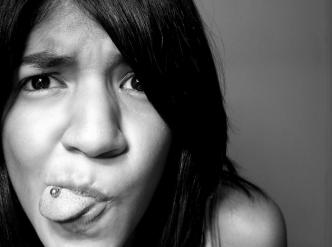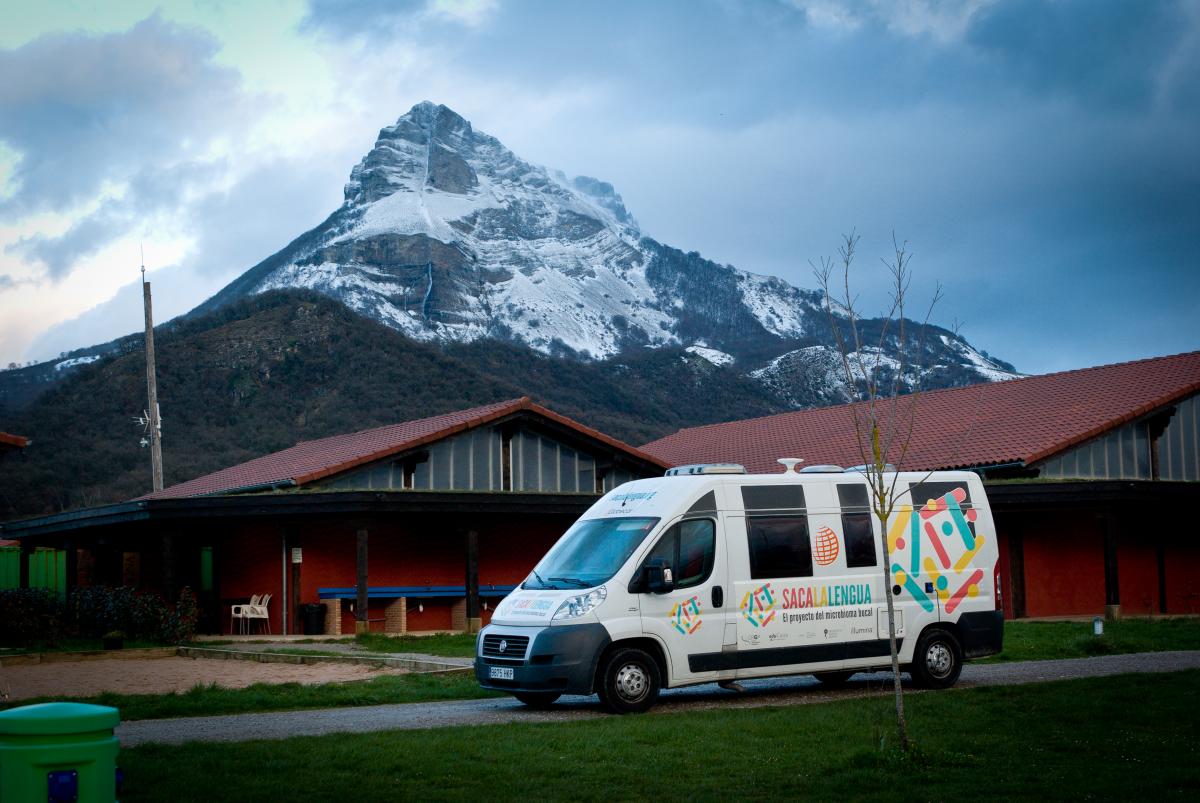A safari in your mouth’s microbial jungle Understand article
A citizen science project travelled over 7000 km to explore the microbial population in students’ mouths.

Image courtesy of Luis Bejarano
Pulling your lips away, you open your eyes, smiling at the beautiful eyes in front of you. But that kiss hasn’t just left you both with a warm feeling, a shared moment; that kiss has also swapped microbes from one mouth to the other. It might sound disgusting, but each kiss – along with each cigarette, meal or object that you put in your mouth – can subtly alter the microbial population in your mouth, and ultimately your health
For two and a half months in 2015, researcher Luis Bejarano travelled more than 7000 kilometres around Spain collecting saliva samples from 15-year-olds in 40 schools for a research project called Saca la lengua (Stick your tongue outw1). With just a van equipped with a centrifuge and a freezer, Bejarano collected over 1600 samples. “It’s the longest business trip I’ve ever done,” Luis smiles.
“Our goal is to understand the link between specific behaviours or environments and certain micro-organisms,” explains Toni Gabaldon, who leads the research group in which Luis works, at the Center for Genomic Regulation in Barcelona, Spain. To this end, his team is creating a catalogue of students’ habits and the micro-organisms found in their mouths, including bacteria and fungi.
The project not only involves the students in real research but also provides a huge sample set for the researchers. “Thanks to students’ co-operation, we are carrying out one of the largest-scale studies of mouth microbes done to date,” adds Luis.

A microbial jungle
Single-celled organisms, including bacteria, were first discovered in the 17th century by the Dutch tradesman and scientist Antonie Van Leeuwenhoek when he looked down a microscope at his own saliva and plaque. Today we know that our mouths are a real jungle: a neighbourhood of co-existing species that scientists term the oral microbiome. Every millilitre of saliva contains around 140 million microbes, and there are more than 700 different species in your mouth alone.
In fact, microbes are an integral part of us, inside and out, and we are all home to a huge number of them. At a total weight of around 1.5 kilograms, the microbes in the mouth, gut and skin make up 90% of all the cells in our body (He et al, 2015). In some ways we are more microbiome than human.
The balance between these different microbes is constantly in flux, and fights between microbes are common: the antibiotics that now save lives across the world are based on the weapons that microbes use to compete with each other for territory and food.
Scientists are discovering that the mouth microbiome not only contains microbes that cause tooth decay, but also is clearly linked to various conditions including pancreatic cancer, atherosclerosis (a type of heart disease), diabetes and obesity (see box and He et al, 2015). Are the microbes in the mouth the cause or consequence of these diseases? And how do the micro-organisms influence distant organs? Scientists don’t yet know the answers to these questions, but if the oral microbiome changes during the early stages of disease, detecting these changes with a saliva test could help doctors diagnose these conditions with a very simple sampling method: a mouthwash. It was these questions that took Luis out onto the road, visiting high schools and asking for students’ help – and their spit.
‘Stick your tongue out’
Luis spent three to four hours in each school, explaining the research project and talking about the life of a scientist. “I tried to show the students that science can be a lot of fun,” he explains, adding, “I myself enjoy working in the lab a lot.” After the introduction, student volunteers filled in an anonymous survey with lifestyle questions. Many of these questions came from students themselves who, months earlier, had helped define the lifestyle variables to be sampled and analysed. Through this collective brainstorming, scientists collected data on a number of interesting habits such as nail biting, pen biting or mouth kissing, none of which they had originally thought to include. The students then briefly rinsed their mouths with a saline buffer (a pH-controlled solution) and spat into a test tube to provide their sample.

Image courtesy of Luis Bejarano
Back in the lab, the researchers have to be creative to identify all the microbial species in each sample. “Classically, the study of micro-organisms is done by culturing them on a dish in the lab,” says Toni, “but this is not possible with around 50% of the microbes that live in the mouth: they just don’t grow.” Instead, the team turned to genomic analysis to identify all the species by using the microbes’ DNA. The team will look for specific, characteristic DNA sequences and compare these across organisms to determine what species are in each mouth.
Luis’s sampling adventure ended in April 2015 and since then the laboratory has been busy processing the samples to obtain and read the genomic data. Students and the wider public are now helping with the analysis and interpretation of the data, from performing statistical analysis of the survey responses and proposing new ways to visualise the collected data, to performing bioinformatics analysis similar to that described in Tenorio (2014). Those participants providing insights may appear as authors on the resulting research papers, as well as winning a trip to Barcelona in 2016 to visit the lab itself.
“I think the students who took part in this project enjoyed it a lot: it was a completely new and different activity,” concludes Luis. If nothing else, the students will have a much clearer idea of what it means to kiss someone, microbially speaking.
Mouth microbes: the good, the bad and the ugly
While researchers are still piecing together the complex microbiome from all of the samples collected in Spain this year, we already know that an excess or lack of certain microbes in the mouth is associated with various phenomena.
- On the teeth: Streptococcus mutans and several other bacteria cause cavities, but some other Streptococcus spp. prevent the colonisation of microbes that cause periodontitis (gum disease). Smoking is known to be an important risk factor for periodontitis, possibly because it impairs this protective function of Streptococcus spp. (He et al, 2015).
- On the tongue: bad breath (halitosis) is the consequence of volatile sulfur compounds and malodorous fatty acids produced during the decomposition of amino acids and proteins by several microbes (Solobacterium moorei, Atopobium parvulum and Eubacterium sulci). People with halitosis also lack some microbes that are normally present on the tongue, including Streptococcus salivarius and Rothia mucilaginosa (He et al, 2015).
- In the saliva: the presence of Neisseria elongata and Streptococcus mitis might predict the presence of pancreatic cancer with 80–90% accuracy (Michaud & Izard, 2014), and Selenomonas noxia has been linked with obesity (Yoshizawa et al, 2013).
References
- Chambers PJ, Pretorius IS (2010) Fermenting knowledge: the history of winemaking, science and yeast research. EMBO reports 11: 914–920. doi: 10.1038/embor.2010.179
- He J et al (2015) The oral microbiome diversity and its relation to human diseases. Folia Microbiologica 60: 69–80. doi: 10.1007/s12223-014-0342-2
- Michaud DS, Izard J (2014) Microbiota, oral microbiome, and pancreatic cancer. Cancer Journal 20(3): 203–206. doi: 10.1097/PPO.0000000000000046
- Tenorio G (2014) Using biological databases to teach evolution and biochemistry. Science in School 31: 30–34.
- Yoshizawa JM et al (2013) Salivary Biomarkers: Toward future clinical and diagnostic utilities. Clinical Microbiology Reviews 26(4): 781–791. doi: 10.1128/CMR.00021-13
Web References
- w1 – The project website provides up-to-date information on the progress of the ‘Stick your tongue out’ project (in Spanish).
Review
This article is a perfect starting point for introducing biology as a science and as a connection between all major natural sciences, including mathematics. The essence is that biology is the centre of a network in which all other sciences can be tied together, if necessary. Such a network is necessary to explain a wide variety of natural phenomena, and the article proves that one has to use many approaches from different sciences to come to a conclusion.
Secondary-school teachers could use the article as an introduction to the first year of biology onwards, which lends itself to student-centred teaching. The teacher could also guide students to read a scientific paper as part of a comprehension exercise, allowing the students to understand the data and formulate questions to explore the research topics, bouncing questions and answers between them. Discussion topics could be developed by the students, and the teacher should refrain from interfering too much – unless to set facts straight.
Friedlinde Krotscheck, Austria





